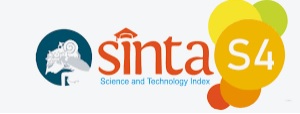Implementasi Gamifikasi untuk Pembelajaran Mitigasi Bencana Tsunami di Sekolah Dasar Nomor 2 Tanjung Benoa
Abstract
This research uses a gamification approach for tsunami disaster mitigation education for students of SD No. 2 Tanjung Benoa, using the Game Development Life Cycle (GDLC) method. The iterative nature of the GDLC technique and its alignment with the requirements of educational game development were the reasons for its selection. This gamification application uses a quiz-based interactive snakes and ladders game to increase students' interest and understanding of disaster mitigation. Black Box testing is used in system testing to verify the functionality of the application. The results show how well the gamification application works to increase students' awareness and preparedness in dealing with the tsunami tragedy. It is expected that the use of this technology will be a successful approach in disaster mitigation education in coastal areas.
Keywords: Black Box Testing; Game Development Life Cycle; Gamification; Tsunami Mitigation
Abstrak
Penelitian ini menggunakan pendekatan gamifikasi untuk pendidikan mitigasi bencana tsunami bagi siswa SD No. 2 Tanjung Benoa, dengan menggunakan metode Game Development Life Cycle (GDLC). Sifat iteratif dari teknik GDLC dan keselarasannya dengan persyaratan pengembangan game edukasi menjadi alasan pemilihannya. Aplikasi gamifikasi ini menggunakan permainan ular tangga interaktif berbasis kuis untuk meningkatkan minat dan pemahaman siswa terhadap mitigasi bencana. Pengujian Black Box digunakan dalam pengujian sistem untuk memverifikasi fungsionalitas aplikasi. Hasilnya menunjukkan seberapa baik aplikasi gamifikasi bekerja untuk meningkatkan kesadaran dan kesiapan siswa dalam menghadapi tragedi tsunami. Diharapkan penggunaan teknologi ini akan menjadi pendekatan yang berhasil dalam pendidikan mitigasi bencana di wilayah pesisir.
Â
Keywords
References
Sularso H.S. Hengkelare, Octavianus H.A. Rogi and Suryono, “Mitigasi Risiko Bencana Banjir Di Manadoâ€, Jurnal Spasial, Vol. 8, No. 2, pp. 267–274, 2021, doi: 10.35793/sp.v8i2.35037.
Rizky, R. and Permatasari, A.L, “Pendidikan Mitigasi Bencana Erupsi Gunungapi Menggunakan Game Edukatif Pasga (Pasukan Siaga Gunungapi)â€, Jurnal Penelitian dan Pengabdian Kepada Masyarakat UNSIQ, Vol. 7, No. 2, 165 – 169, 2020, doi: 10.32699/ppkm.v7i2.973.
Pratomo, A, “Pengaruh Konsep Gamifikasi Terhadap Tingkat Engagement (Studi Kasus Pelatihan Karyawan the Park Lane Jakarta)â€, The Journal: Tourism and Hospitality Essentials Journal, Vol. 8, No. 2, pp. 63–74, 2018, doi: 10.17509/thej.v8i2.13740.
Smiderle, R. et al, “The impact of gamification on students’ learning, engagement and behavior based on their personality traitsâ€, Smart Learning Environments,Vol. 7, No. 3, pp. 6-11, 2020, doi: 10.1186/s40561-019-0098-x.
Wisnumurti, A.S. et al, “Penerapan Gamifikasi Pada Pembelajaran Huruf Dan Angka Untuk Anak Usia Dini Berbasis Androidâ€, JTMEI, vol. 2, no. 1, pp. 20–30, 2023, doi: 10.55606/jtmei.v2i1.1154.
Husniah, L., Pratama, B.F. and Wibowo, H, “Gamification And GDLC (Game Development Life Cycle) Application For Designing The Sumbawa Folklore Game â€The Legend Of Tanjung Menangis (Crying Cape)â€â€, Kinetik: Game Technology, Information System, Computer Network, Computing, Electronics, and Control, Vol. 3, No. 4, pp. 351-358, 2018, doi: 10.22219/kinetik.v3i4.721.
Zahmi, A. and Zaiyen, M.A, “Penerapan Penerapan Metode GDLC (Game Development Life Cycle) Dalam Membangun Aplikasi Game Edukasi Pengenalan Alat Rumah Untuk Anak Usia Diniâ€, Journal of Scientech Research and Development, Vol. 5, No. 2, pp. 945-953, 2024, doi: 10.56670/jsrd.v5i2.270.
Sutmo, F. et al, “Math Runner: Game Edukasi Matematika Untuk Anak Sekolah Dasarâ€, Jurnal Pendidikan dan Teknologi Indonesia, Vol. 3, No. 4, pp. 165-173, 2023, doi:10.52436/1.jpti.286.
Hadiprakoso, R.B. and Agus Satria, W, “Rancang Bangun Aplikasi Gamifikasi Untuk Meningkatkan Kesadaran Keamanan Siberâ€, Jurnal Ilmiah Ilmu Komputer, Vol. 8, No. 2, 2022, doi: 10.35329/jiik.v8i2.232.
Manusakerti, A. and Wibowo, M, “Rancangan dan Evaluasi Usability Pada Aplikasi Website Media Pembelajaran Cyberbullying Menggunakan Metode Gamifikasiâ€, Jurnal Media Informatika Budidarma, Vol. 6, No. 4, pp. 2140-2147, 2022, doi: 10.30865/mib.v6i4.4627.
Triatmaja, Y.K. et al, “Gamification In E-Learning for Playgroupâ€, Proceedings - International Conference on Informatics and Computational Sciences, pp. 146-151, 2020, doi: 10.1109/ICICoS56336.2022.9930568.
Choiriyah, N.N., Putra, F.N. and Mubarok, T.A, “Rancang Bangun Game Edukasi Berbasis Mobile sebagai Media Pembelajaran Bahasa Inggris Menggunakan Metode Game Development Life Cycle untuk Siswa Sekolah Dasarâ€, ILKOMNIKA: Journal of Computer Science and Applied Informatics, Vol. 4, No. 1, pp. 93-103, 2022, doi: 10.28926/ilkomnika.v4i1.433.
Sari, A.C. et al, “Interactive gamification learning media application for blind children using android smartphone in Indonesiaâ€, Procedia Computer Science, Vol. 157, pp. 589-595, 2019, doi: 10.1016/j.procs.2019.09.018.
Nathaniel, V, "Penerapan Gamifikasi Pada Proses Belajar Matematika untuk Anak Sekolah Dasar Untuk Meningkatkan Motivasi Belajar Siswa," J. ICTEE, vol. 3, no. 2, pp. 46-50, 2023. doi:10.33365/jictee.v3i2.2300.
S. Wahyu and J. Gotama, “Pengembangan Game Edukasi Pendidikan Agama Buddha Berbasis Progressive Web Apps Dengan Model Gamifikasi Dan Gdlcâ€, SKANIKA, vol. 7, no. 1, pp. 85-97, 2024. doi:10.36080/skanika.v7i1.3145.
A. Sucipto et al., "Penerapan Sistem Informasi Profil Berbasis Web di Desa Bandarsari," J. Technol. Soc. Community Serv., vol. 3, no. 1, pp. 29-37, 2022. doi: 10.33365/jsstcs.v3i1.1512.
How To Cite This :
Refbacks
- There are currently no refbacks.











